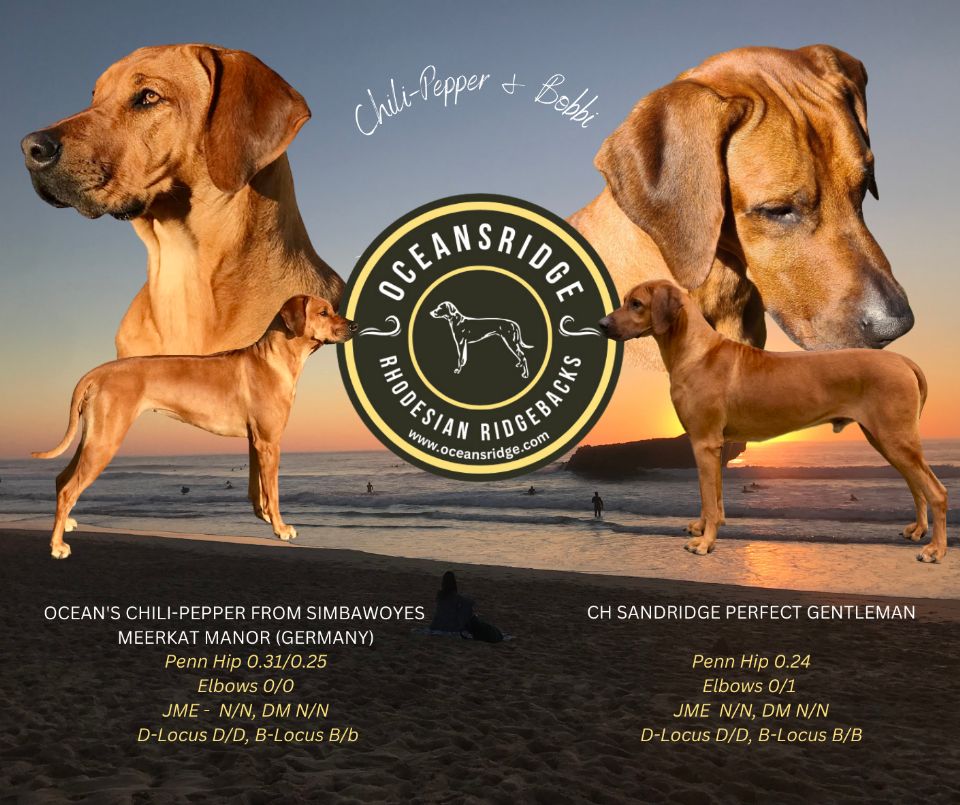About Rhodesian Ridgebacks
The Breed
(American Kennel Club) The Rhodesian Ridgeback is an all-purpose 'Renaissance hound' whose hallmark is the ridge, or stripe of backward-growing hair, on his back. Though the breed was made famous in its native Africa for its skill at tracking and baying, but never, ever killing, lions, today Ridgebacks are cherished family dogs whose owners must be prepared to deal with their independence and strong prey drive.
Beneath the Ridgeback's trademark ridge is a whole lot of hound: Ridgebacks are fast and powerful athletes who can weigh between 70 and 85 pounds, and oftentimes more. They come in only one color, wheaten, which spans every shade seen in a wheat field, from pale flaxen to the burnished red of a maturing crop. Ridgebacks also have two nose colors: black and the less commonly seen brown. The formidable Ridgeback can be strong-willed, independent, and sometimes domineering. Ridgebacks must be guided with a firm but a fair hand from puppyhood. They are faithful friends, protective of their loved ones, and meltingly affectionate with those whom they trust.
Breed Standard (UK Kennel Club)
General appearance
Handsome, strong, muscular and active dog, symmetrical in outline, capable of great endurance with fair amount of speed. Mature dog is handsome and upstanding.
Characteristics
A distinctive feature is the ridge on the back formed by hair growing in opposite direction to the remainder of coat. Ridge clearly defined, tapering and symmetrical, starting immediately behind shoulders and continuing to haunch, and containing two identical crowns only, opposite each other, lower edges of crowns not extending further down ridge than one-third of its length. Up to 5 cm (2 ins) is a good average for width of ridge.
Temperament
Dignified, intelligent, aloof with strangers but showing no aggression or shyness.
Head and skull
Of fair length, skull flat, rather broad between ears, free from wrinkles when in repose. Stop reasonably well defined. Nose black or brown in keeping with colour of dog. Black nose accompanied by dark eyes, brown nose by amber eyes. Muzzle long, deep and powerful. Lips clean and close fitting.
Eyes
Set moderately well apart, round, bright and sparkling with intelligent expression, colour harmonising with coat colour.
Ears
Set rather high, medium size, rather wide at base, gradually tapering to a rounded point. Carried close to head.
Mouth
Jaws strong, with a perfect, regular and complete scissor bite, i.e. upper teeth closely overlapping lower teeth and set square to the jaws. Well-developed teeth, especially canines.
Neck
Fairly long, strong and free from throatiness.
Forequarters
Shoulders sloping, clean and muscular. Forelegs perfectly straight, strong, heavy in bone; elbows close to body.
Body
Chest not too wide, very deep and capacious; ribs moderately well sprung, never barrel-ribbed. Back powerful; loins strong, muscular and slightly arched.
Hindquarters
Muscles clean, well defined; good turn of stifle; hocks well let down.
Feet
Compact, well-arched toes, round, tough, elastic pads, protected by hair between toes and pads.
Tail
Strong at root, not inserted high or low, tapering towards end, free from coarseness. Carried with a slight curve upwards, never curled.
Gait/movement
Straight forward, free and active.
Coat
Short and dense, sleek and glossy in appearance, but neither woolly nor silky.
Colour
Light wheaten to red wheaten. Head, body, legs and tail of uniform colour. Little white on chest and toes permissible, but excessive white hairs here, on belly or above paws undesirable. Dark muzzle and ears permissible.
Size
Dogs: 63 cms (25 ins) desirable minimum height at withers; 69 cms (27 ins) desirable maximum height at withers; bitches: 61 cms (24 ins) desirable minimum height at withers, 66 cms (26 ins) desirable maximum height at withers.
Faults
Any departure from the foregoing points should be considered a fault and the seriousness with which the fault should be regarded should be in exact proportion to its degree and its effect upon the health and welfare of the dog and on the dog’s ability to perform its traditional work.
Note
Male animals should have two apparently normal testicles fully descended into the scrotum.
*Note for prospective puppy buyers
Size – The Kennel Club breed standard is a guide and description of the ideal for the breed; the size as described does not imply that a dog will match the measurements given (height or weight). A dog might be larger or smaller than the size measurements stated in the breed standard.
